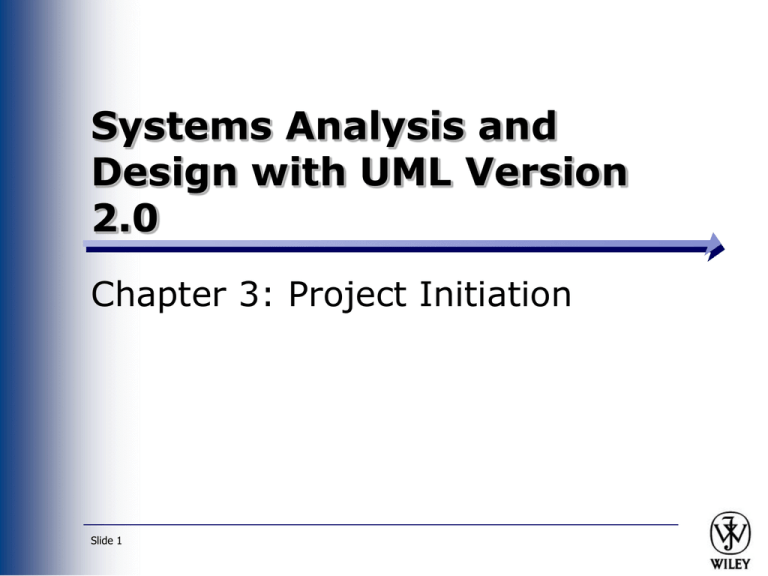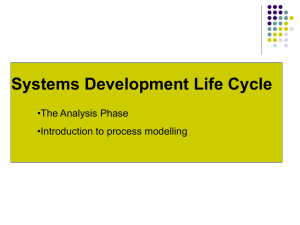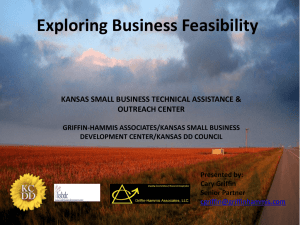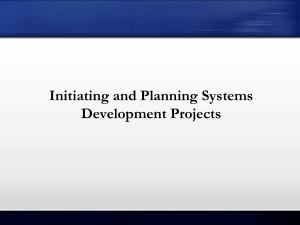Systems Analysis and Design Allen Dennis and Barbara Haley Text
advertisement

Systems Analysis and Design with UML Version 2.0 Chapter 3: Project Initiation Slide 1 Key Ideas Projects being when someone sees an opportunity to create business value from using information technology. Feasibility analysis is used to aid in the decision of whether or not to proceed with the IS project. Slide 2 Key Ideas The project sponsor is a key person proposing development or adoption of the new information technology . The approval committee reviews proposals from various groups and units in the organization and decides which to commit to developing. Slide 3 System Request A system request is a document that describes the business reasons for building a system and the value that the system is expected to provide. The completed system request is submitted to the approval committee for consideration. Slide 4 System Request Most system requests include five elements: Project sponsor Business need Functionality Expected value Special issues or constraints Slide 5 Applying the Concepts at CD Selections CD Selections is a chain of fifty music stores located in California, with headquarters in Los Angeles. Margaret Mooney, Vice President of Marketing, has recently become both excited by and concerned with the rise of Internet sites selling CDs. The Internet has great potential, but Margaret wants to use it in the right way. Rushing into e-commerce without considering things like its effect on existing brick-andmortar stores and the implications on existing systems at CD Selections could cause more harm than good. CD Selections currently has a Web site that provides basic information about the company and about each of its stores. (See page 63). Slide 7 FEASIBILITY ANALYSIS Slide 9 Feasibility Analysis Feasibility analysis guides the organization in determining whether to proceed with a project. Feasibility analysis also identifies the important risks associated with the project that must be addressed if the project is approved. Slide 10 Feasibility Analysis Detailing Expected Costs and Benefits Technical feasibility Economic feasibility Organizational feasibility Slide 11 Technical Feasibility: Can We Build It? The extent to which the system can be successfully designed, developed, and installed by the IT group. Technical feasibility analysis is in essence a technical risk analysis that strives to answer the question: “Can we build it?” Slide 12 Technical Feasibility Factors: Familiarity with application Knowledge of business domain. Familiarity with technology Extension of existing firm technologies. Project size Number of people, time, and features. Compatibility: The harder it is to integrate the system with the company’s existing technology. Slide 13 Economic Feasibility Should We Build It? An economic feasibility analysis (also called a cost–benefit analysis) identifies the financial risk associated with the project. Economic feasibility is determined by identifying costs and benefits associated with the system, assigning values to them, and then calculating the cash flow and return on investment for the project. This attempts to answer the question: “Should we build the system?” Slide 14 Economic Feasibility Factors: Development costs Annual operational costs Annual benefits Intangible costs and benefit Slide 15 Example Costs and Benefits Assign Values to Costs and Benefits Cash Flow Method for Cost Benefit Analysis Slide 18 Organizational Feasibility If we build it, will they come? Organizational feasibility of the system determining how well the system ultimately will be accepted by its users and incorporated into the ongoing operations of the organization. Slide 19 Organizational Feasibility If we build it, will they come? Project champion(s) The champion is a high-level non-IS executive who is usually but not always the person who created the system request. Organizational management management should encourage people to use the system and to accept the changes that the system will likely create. System users Slide 20 Applying the Concepts at CD Selections A senior systems analyst, Alec Adams, was assigned to help Margaret conduct a feasibility analysis because of his familiarity with CD Selections’ sales and distribution systems. Alec and Margaret worked closely together over the next few weeks on the feasibility analysis. (See page 75) Slide 21 Summary Project initiation involves creating and assessing goals and expectations for a new system The system request describes an overview of the proposed system. The feasibility study is concerned with insuring that technical, economic, and organizational benefits outweigh costs and risks Slide 22









